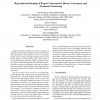Free Online Productivity Tools
i2Speak
i2Symbol
i2OCR
iTex2Img
iWeb2Print
iWeb2Shot
i2Type
iPdf2Split
iPdf2Merge
i2Bopomofo
i2Arabic
i2Style
i2Image
i2PDF
iLatex2Rtf
Sci2ools
114
click to vote
AIPR
2002
IEEE
2002
IEEE
Hyperspectral Imaging of Kaposi's Sarcoma for Disease Assessment and Treatment Monitoring
Light spectroscopic methods are critical to advances in molecular characterization of disease processes. However, these methods have been limited to in-vitro or cell culture studies. In fact, strong scattering in almost all tissue types causes dispersion of the photons paths which results in poor localization and resolution. Hence, quantitative analysis of spectral data obtained from structures below the tissue surface requires accounting for scattering which affects both the penetration of the photons and the path length over which the photons will be subject to molecularly speci£c absorption. The goal of much current research is to non-invasively obtain diagnostically useful molecular information from embedded sites. We have designed and built a six-band multi-spectral NIR imaging system which we have used on patients with highly vascularized tumors in the skin called Kaposi’s Sarcoma. The imaged lesions are undergoing treatment with experimental anti-angiogenesis drugs that are ...
| Added | 14 Jul 2010 |
| Updated | 14 Jul 2010 |
| Type | Conference |
| Year | 2002 |
| Where | AIPR |
| Authors | David Hattery, Moinuddin Hassan, Stavros Demos, Amir Gandjbakhche |
Comments (0)

